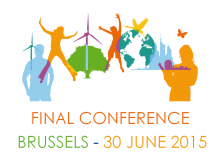This study addresses the issue of carbon leakage and international competitiveness of the European energy‐intensive industries, with a focus on the European steel industry. The study shows several ways in which the European steel sector can be incentivised and supported to improve its energy and material consumption, reduce dependency on fossil fuels technologies and invest in innovative technologies and products which in the long term, would reduce carbon costs as part of the production costs and improve international competitiveness. The study finds that due to the complexity of the steel sector an one‐solution‐fits‐all approach is not the right approach. The study recommends tailored consultation processes with each industry individually that involve various experts in order to guarantee a balanced representation of interests to better understand and address subsectoral differences. The study also recommends the redirection of revenues from the sale of emissions allowances into measures supporting the industry to invest in abatement technologies in order to reduce the industry’s carbon costs while supporting research and innovation.
Attachment:
Citation:
Funding:
Year of publication:
Number of pages:
Table of contents:
|
1 |
Executive summary |
8 |
|
2 |
Introduction |
8 |
|
3 |
Conceptual framework |
10 |
|
3.1 |
Definitions of concepts |
10 |
|
3.1.1 |
Carbon leakage |
10 |
|
3.1.2 |
Channels of carbon leakage |
12 |
|
3.1.3 |
Competitiveness |
12 |
|
3.1.4 |
Defining energy-intensive industries – focus on the steel sector |
13 |
|
3.2 |
Technological innovation |
13 |
|
3.3 |
Evaluation criteria and indicators for assessing policy options |
15 |
|
3.3.1 |
Environmental effectiveness |
16 |
|
3.3.2 |
Dynamic efficiency |
18 |
|
3.3.3 |
Political feasibility |
20 |
|
3.3.4 |
Legal feasibility |
22 |
|
3.4 |
Concluding remarks |
23 |
|
4 |
Carbon leakage and competitiveness aspects in the European steel sector |
24 |
|
4.1 |
The policy framework for assessing carbon leakage risk at EU level - focus on the steel sector |
24 |
|
4.2 |
Carbon leakage risk for the European steel sector |
26 |
|
4.2.1 |
Carbon costs |
26 |
|
4.2.1.1 |
Direct carbon costs |
26 |
|
4.2.1.2 |
Indirect carbon costs as part of the energy costs |
28 |
|
4.2.2 |
Trade intensity |
29 |
|
4.2.2.1 |
Direct trade of steel |
30 |
|
4.2.2.2 |
Indirect trade intensity – trade of products containing steel |
30 |
|
4.3 |
The carbon leakage risk and competitiveness arguments in the European steel sector |
30 |
|
4.4 |
Rethinking competitiveness - steel potential for innovation, a value-chain perspective |
34 |
|
5 |
Methodology |
35 |
|
6 |
Results: Assessment of policy options |
38 |
|
6.1 |
Evaluating current measures for carbon leakage protection taken by the EU |
39 |
|
6.1.1 |
Free allocation for emissions costs |
39 |
|
6.1.1.1 |
Environmental effectiveness |
41 |
|
6.1.1.2 |
Dynamic efficiency |
41 |
|
6.1.1.3 |
Political feasibility |
42 |
|
6.1.1.4 |
Legal feasibility |
43 |
|
6.1.2 |
Compensations for electricity costs |
44 |
|
6.1.2.1 |
Environmental effectiveness |
45 |
|
6.1.2.2 |
Dynamic efficiency |
47 |
|
6.1.2.3 |
Political feasibility |
47 |
|
6.1.2.4 |
Legal feasibility |
47 |
|
6.2 |
Redesigning current measures to induce more technological innovation |
49 |
|
6.2.1 |
Redesigning free allocation to induce more innovation |
49 |
|
6.2.1.1 |
Environmental effectiveness |
49 |
|
6.2.1.2 |
Dynamic efficiency |
50 |
|
6.2.1.3 |
Political feasibility |
50 |
|
6.2.1.4 |
Legal feasibility |
51 |
|
6.1.1 |
Redesigning compensations for electricity costs to induce more technological innovation |
53 |
|
6.2.2.1 |
Environmental effectiveness |
54 |
|
6.2.2.2 |
Dynamic efficiency |
55 |
|
6.2.2.3 |
Political feasibility |
55 |
|
6.2.2.4 |
Legal feasibility |
56 |
|
6.3 |
More support to the European industrial innovation |
58 |
|
6.3.1 |
Environmental effectiveness |
60 |
|
6.3.2 |
Dynamic efficiency |
61 |
|
6.3.3 |
Political feasibility |
62 |
|
6.3.4 |
Legal feasibility |
64 |
|
6.4 |
Policies including third countries – Border carbon adjustment measures |
65 |
|
6.4.1 |
Environmental effectiveness |
66 |
|
6.4.2 |
Dynamic efficiency |
66 |
|
6.4.3 |
Political feasibility |
67 |
|
6.4.4 |
Legal feasibility |
67 |
|
|
Border carbon adjustment measures |
68 |
|
7 |
Conclusion and recommendations |
68 |
|
8 |
References |
71 |
|
9 |
Annexes |
81 |
|
9.1 |
Annex 1 – Definitions of carbon leakage |
81 |
|
9.2 |
Annex 2 – Data on energy and carbon costs in the European steel industry |
83 |
|
9.3 |
Annex 3 – Technological production paths in the European steel sector |
88 |
|
9.4 |
Annex 4 – List of documents consulted representing main policy and legislative documents of the European Commission and documents for the position of Eurofer |
91 |
|
9.5 |
Annex 5 – List of notes from the workshops on carbon leakage on the aspects mentioned about carbon leakage and technological innovation |
94 |
|
9.6 |
Annex 6 – List of interviews and questionnaires |
100 |


